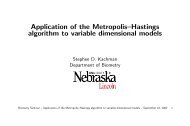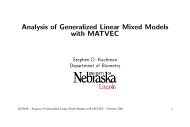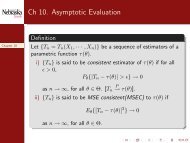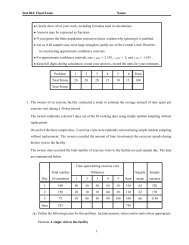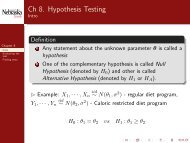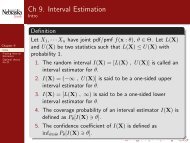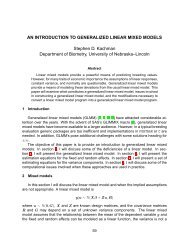Matvec Users’ Guide
Matvec Users' Guide
Matvec Users' Guide
- No tags were found...
Create successful ePaper yourself
Turn your PDF publications into a flip-book with our unique Google optimized e-Paper software.
13.2. CONTINUOUS DISTRIBUTION 95<br />
13.2.4 t distribution<br />
Definition<br />
The random variable X has a non-central t distribution if its probability density function (pdf) is defined by<br />
f(x) = exp(δ2 /2)Γ((r + 1)/2) r<br />
√ (<br />
πrΓ(r/2) r + x 2 )(r+1)/2 (13.5)<br />
[<br />
∞∑ Γ((r + j + 1)/2) xδ √ ] j<br />
2<br />
×<br />
√ , −∞ < x < ∞ (13.6)<br />
j!Γ((r + 1)/2) r + x<br />
2<br />
j=0<br />
where r (integer) and δ (real) are the parameters with their ranges r ≥ 1, −∞ < δ < ∞; r is commonly<br />
called the degrees of freedom and δ non-centrality parameter. In short, we say X ∼ t(r, δ).<br />
Alternatively, If Z ∼ N(δ, 1) and U ∼ χ 2 (r) are independent then the random variable<br />
X =<br />
Z √<br />
U/r<br />
is called the non-central t distribution with r degrees of freedom and non-centrality parameter δ.<br />
When δ = 0, the p.d.f of t(r, δ) reduces to<br />
Γ((r + 1)/2) r<br />
f(x) = √ ( πrΓ(r/2) r + x 2 )(r+1)/2 (13.7)<br />
we say X ∼ t(r) which is commonly called (central) t distribution.<br />
For example, if X 1 , X 2 , . . . , X n is a random sample from N(µ, σ 2 ), then<br />
¯X − µ<br />
σ √ n<br />
∼ N(0, 1), (n − 1)<br />
s2<br />
σ 2 ∼ χ2 (n − 1),<br />
and both are independent. Thus,<br />
Because<br />
Thus,<br />
¯X − µ<br />
s/ √ n<br />
∼ t(n − 1)<br />
¯X<br />
σ √ ∼ N(µ, 1)<br />
n<br />
¯X<br />
s/ √ n ∼ t(n − 1, µ<br />
σ √ n )<br />
Properties<br />
1. E(X) = (r/2) 1/2 Γ((r−1)/2)<br />
Γ(r/2)<br />
δ, Var(X) = r<br />
r−2 (1 + δ2 ) − E 2 (X).<br />
<strong>Matvec</strong> interface<br />
An object of t(r, δ) can be created by<br />
> D = StatDist("t",r,delta)<br />
> D = StatDist("t",r)<br />
<strong>Matvec</strong> provided several standard member functions to allow user to access most of properties and<br />
functions of t(r, δ):<br />
pdf D.pdf(x) returns the probability density function (pdf) values of x which could be a vector or matrix.




